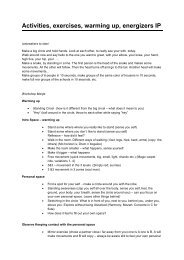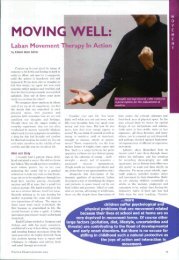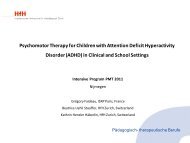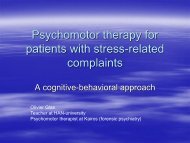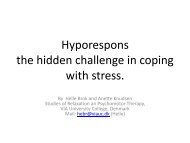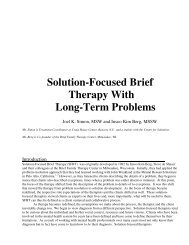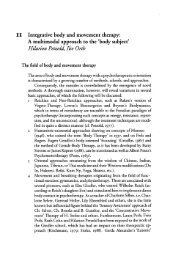Factors and Processes Contributing to Resilience
Factors and Processes Contributing to Resilience
Factors and Processes Contributing to Resilience
Create successful ePaper yourself
Turn your PDF publications into a flip-book with our unique Google optimized e-Paper software.
188 Karol L. KumpFer<br />
from highwrisk samples function comparably <strong>to</strong> wellwfunctioning children in<br />
general population samples (Luthar & Zigler, 1991).<br />
Occasionally these prospective studies begin after the occurrence of<br />
a specific traumatic event, such as child abuse or parental divorce. Such<br />
studies can be criticized for not having data on the child's adjustment prior<br />
<strong>to</strong> the onset of the major stressor or risk fac<strong>to</strong>r. Causality is difficult <strong>to</strong><br />
determine since these children may have poor life adjustment or behaviors<br />
prior <strong>to</strong> the trauma.<br />
Prospective, Multiple Sampie Studies<br />
This type of design is used by developmental researchers interested in<br />
comparing children in the general population with a high-risk population<br />
over time (Conger et al., 1992; Kumpfer, Molgaard, & Spoth, in press).<br />
Matched pairs or families are sometimes used as control groups (Johnson,<br />
Glassman, Fiks, & Rosen, 1990). This design could be used with many prevention<br />
sturlies where one group is given an intervention, another is not,<br />
<strong>and</strong> a generat population sample exists for comparison. Using this type of<br />
design, Abelson, Zigler, & DeBlasi (1974) <strong>and</strong> Mulholl<strong>and</strong> <strong>and</strong> associates<br />
(1991) discovered that the resilient children in high-risk groups did not<br />
equal the attainment of the normal, low-risk groups. This type of design<br />
is encouraged by Luthar <strong>and</strong> Cushing (1996) <strong>to</strong> answer the question of<br />
whether the most resilient individuals of a high-risk group truly resilient or<br />
are simply the best of a generally poorly functioning group.<br />
Outcome Research Pertaining <strong>to</strong> the Six Resiliency Predic<strong>to</strong>r<br />
Areas of the <strong>Resilience</strong> Framework<br />
Outcome research on resilience was organized in<strong>to</strong> the six predic<strong>to</strong>r<br />
areas of the proposed resiliency framework, namely: 1) the acute stressor or<br />
challenge, 2) the cxternal environmental context, 3) person-environment<br />
interactional processes, 4) internalself characteristics or resiliency fac<strong>to</strong>rs, 5)<br />
resiliency processes, <strong>and</strong> 6) the positive outcome. Research on each of these<br />
six resilience predic<strong>to</strong>r areas are discussed below in their own sections.<br />
The Acute Stressor or Cha/lenge<br />
The resiliency framework or process begins with an initiating event<br />
<strong>and</strong> ends with an outcome, hopefully a successful one that demonstrates



